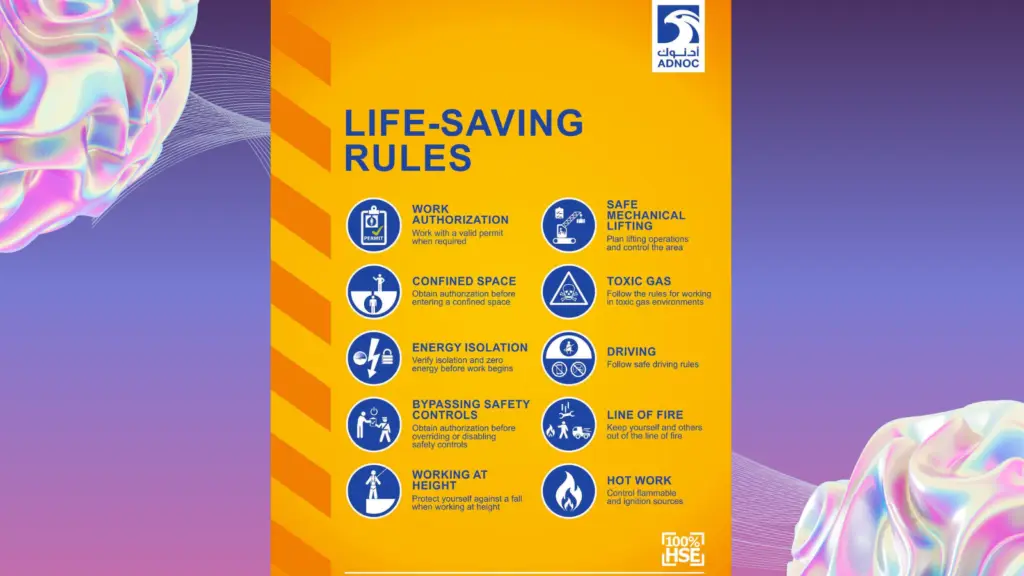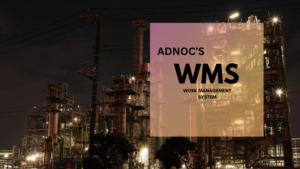
Introduction
In high-risk industries like oil and gas, safety is paramount. ADNOC’s 10 Life-Saving Rules are designed to protect workers and prevent accidents in the workplace. These rules target critical areas where the potential for risk is highest, and their purpose is to promote a culture of vigilance, accountability, and safety. In this guide, we will break down each of ADNOC’s 10 Life-Saving Rules to explain their importance and how to ensure compliance.
The ADNOC’s 10 Life-Saving Rules
1. Work Authorization: Work with a Valid Permit When Required
Before engaging in any task, always ensure that you have the appropriate work permit. This vital rule ensures that all risks have been properly assessed and the necessary safety measures are in place. A valid permit indicates that the work has been authorized and is safe to proceed.
2. Bypassing Safety Controls: Obtain Authorization Before Overriding or Disabling Safety Controls
Safety controls are put in place to protect workers from potential hazards. Never bypass or disable these systems unless you have received the proper authorization. Unauthorized actions can lead to accidents, injuries, or even system failures that could have severe consequences.
3. Confined Space: Obtain Authorization Before Entering a Confined Space
Confined spaces present unique hazards due to limited ventilation and potential exposure to dangerous gases or chemicals. Before entering such spaces, always obtain the necessary authorization and ensure that proper safety measures, such as air quality monitoring and emergency evacuation plans, are in place.
4. Driving: Follow Safe Driving Rules
When driving company vehicles or equipment, always follow traffic regulations. This includes wearing a seatbelt, refraining from using mobile phones while driving, and obeying speed limits. Safe driving is critical to preventing accidents and protecting lives on and off the worksite.
5. Energy Isolation: Verify Isolation and Zero Energy Before Work Begins
Before starting any work on equipment or machinery, verify that all energy sources are fully isolated and that no residual energy remains. This simple but crucial step ensures that machinery cannot accidentally activate during maintenance or repair activities, preventing accidents.
6. Hot Work: Control Flammables and Ignition Sources
Hot work activities, such as welding or cutting, pose significant fire risks. Always control all flammable materials and ignition sources around the work area. Implementing proper fire safety measures ensures the safety of workers and prevents fires or explosions from occurring.
7. Line of Fire: Keep Yourself and Others Out of the Line of Fire
Avoid putting yourself or your colleagues in potentially hazardous situations by staying clear of “the line of fire.” This includes avoiding areas where heavy machinery or falling objects could pose a risk, and ensuring that workers are always positioned in a safe location during operations.
8. Safe Mechanical Lifting: Plan Lifting Operations and Control the Area
Mechanical lifting operations require detailed planning and strict safety measures. Always inspect lifting equipment, ensure the load is properly secured, and clearly define a safe work area to prevent accidents caused by mishandling or falling loads.
9. Toxic Gas: Follow the Rules for Working in Toxic Gas Environments
Working in environments with toxic gases presents serious health risks. Ensure that proper gas detection systems are in place and always wear the required personal protective equipment (PPE). Complying with safety protocols can significantly reduce the risk of exposure to hazardous gases.
10. Working at Height: Protect Yourself Against a Fall When Working at Height
Falls from height are one of the leading causes of workplace injuries. When working at elevated positions, always use appropriate fall protection systems, such as harnesses, guardrails, and safety nets, to prevent accidents.
Why These Rules Matter
ADNOC’s Life-Saving Rules are designed to:
- Prevent Accidents: By addressing high-risk activities, these rules help minimize the occurrence of accidents and injuries.
- Promote Safety Awareness: Encouraging all personnel to prioritize safety ensures a culture of vigilance and accountability.
- Ensure Compliance: Following these rules helps ADNOC meet regulatory and Health, Safety, and Environmental (HSE) standards, fostering a safer workplace.
By adhering to these guidelines, workers contribute to a safer and more productive working environment.
Tips for Effective Implementation
- Training: Regular training sessions should be conducted to ensure all employees understand and follow the Life-Saving Rules.
- Supervision: Designate safety officers or supervisors to monitor compliance and provide immediate guidance when needed.
- Communication: Foster ongoing discussions about safety during toolbox talks, meetings, and daily briefings to reinforce the importance of these rules.
- Reporting: Create an open environment where workers feel comfortable reporting safety violations or potential hazards without fear of retaliation.
Conclusion
ADNOC’s 10 Life-Saving Rules are more than just guidelines—they are a commitment to protecting lives and ensuring the safety of workers across all operations. By understanding and implementing these rules, every individual plays a role in creating a workplace that prioritizes safety above all. Let’s work together to make “zero incidents” a reality in our industry.
Your Safety, Our Priority. Follow ADNOC’s Life-Saving Rules Today!
By following ADNOC’s Life-Saving Rules, you are contributing to a safer, more secure work environment. These measures not only ensure your safety but also protect the well-being of your colleagues. Let’s make safety a daily habit!




